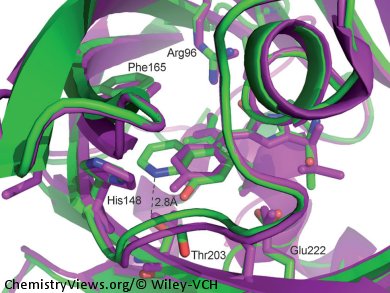Metal-binding unnatural amino acids (UAAs) are used in protein research in a variety of applications such as protein sensors, for metalloenzyme engineering, and for protein NMR spectroscopy. They allow the site-specific incorporation of labels in proteins during their synthesis without requiring further – often damaging and unspecific – reactions on the protein after its purification. However, the complex synthetic routes to UAAs cause limitations in applicability.
Jiangyun Wang, Chinese Academy of Sciences, Beijing, China, and colleagues synthesized a novel metal-chelating UAA in a single step by the use of a mutated enzyme. This new UAA has an 8-hydroxyquinoline functional group (HqAla) that forms stable complexes with most transition metal ions. By substitution of the tyrosine with HqAla in various fluorescent proteins, the excitation and emission maxima are significantly shifted to higher wavelengths (red-shift). This further extends the applications of fluorescent proteins.
In subsequent studies the metal-chelating properties of HqAla incorporated in the green fluorescent protein (GFP) were demonstrated by changes in fluorescence. HqAla in fluorescent proteins exhibits unique metal-chelating and metal-ion-sensing abilities.
- Significant Expansion of the Fluorescent Protein Chromophore through the Genetic Incorporation of a Metal-Chelating Unnatural Amino Acid,
Xiaohong Liu, Jiasong Li, Cheng Hu, Qing Zhou, Wei Zhang, Meirong Hu, Juanzuo Zhou, Jiangyun Wang,
Angew. Chem. Int. Ed. 2013.
DOI: 10.1002/anie.201301307



